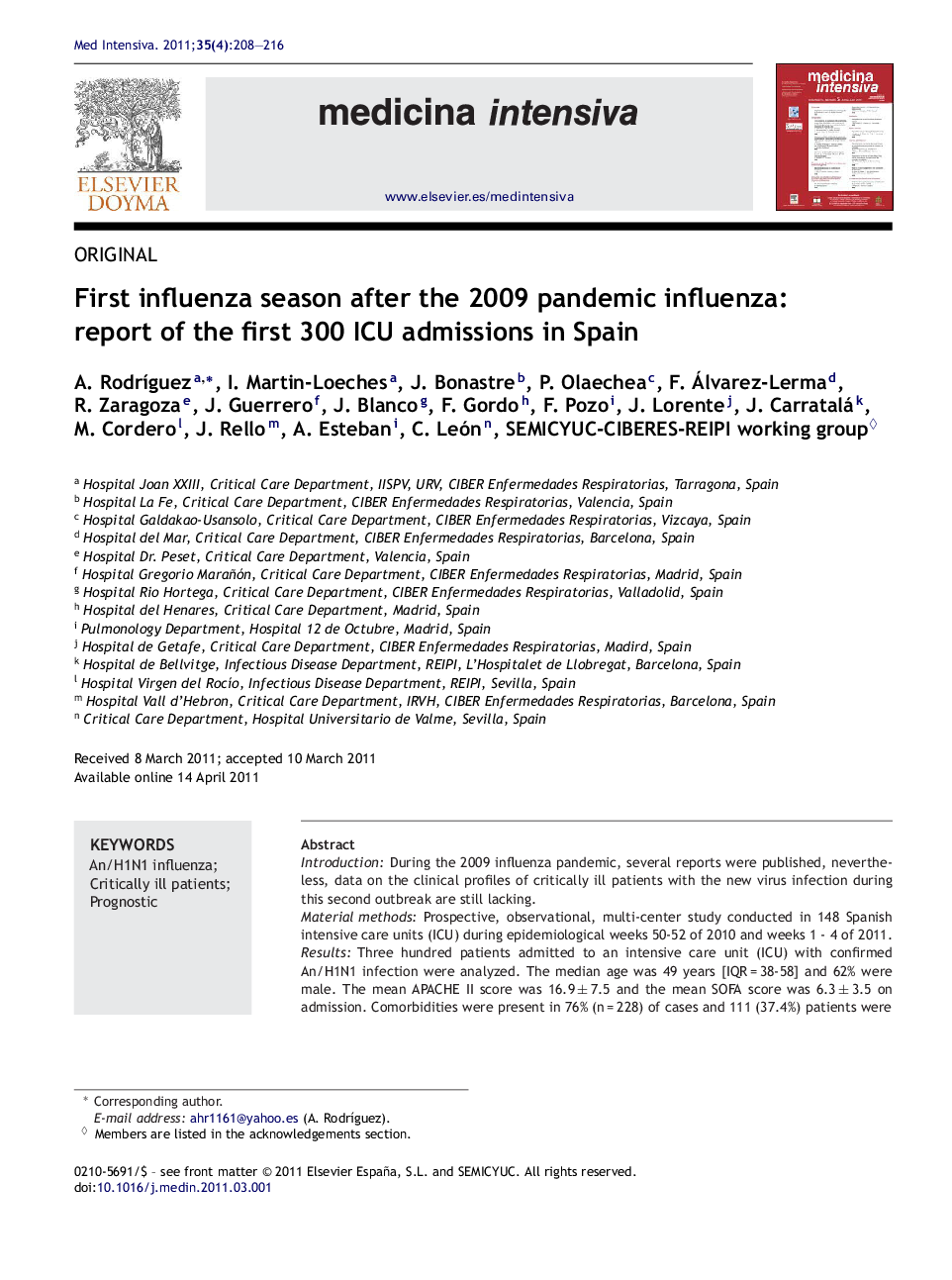| Article ID | Journal | Published Year | Pages | File Type |
|---|---|---|---|---|
| 3114362 | Medicina Intensiva (English Edition) | 2011 | 9 Pages |
IntroductionDuring the 2009 influenza pandemic, several reports were published, nevertheless, data on the clinical profiles of critically ill patients with the new virus infection during this second outbreak are still lacking.Material methodsProspective, observational, multi-center study conducted in 148 Spanish intensive care units (ICU) during epidemiological weeks 50–52 of 2010 and weeks 1–4 of 2011.ResultsThree hundred patients admitted to an intensive care unit (ICU) with confirmed An/H1N1 infection were analyzed. The median age was 49 years [IQR = 38–58] and 62% were male. The mean APACHE II score was 16.9 ± 7.5 and the mean SOFA score was 6.3 ± 3.5 on admission. Comorbidities were present in 76% (n = 228) of cases and 111 (37.4%) patients were reportedly obese and 59 (20%) were COPD. The main presentation was viral pneumonia with severe hypoxemia in 65.7% (n = 197) of the patients whereas co-infection was identified in 54 (18%) patients. All patients received antiviral treatment and initiated empirically in 194 patients (65.3%), however only 53 patients (17.6%) received early antiviral treatment. Vaccination was only administered in 22 (7.3%) patients. Sixty-seven of 200 patients with ICU discharge died. Haematological disease, severity of illness, infiltrates in chest X-ray and need for mechanical ventilation were variables independently associated with ICU mortality.ConclusionsIn patients admitted to the ICU in the post-pandemic seasonal influenza outbreak vaccination was poorly implemented and appear to have higher frequency of severe comorbidities, severity of illness, incidence of primary viral pneumonia and increased mortality when compared with those observed in the 2009 pandemic outbreak.
ResumenIntroducciónDurante la pandemia de gripe A, se publicaron diferentes comunicaciones. No obstante, el perfil clínico de los pacientes críticos afectados por este virus durante este segundo brote epidémico es poco conocido.Material y métodosEstudio prospectivo, observacional y multicéntrico realizado en 148 UCI espãnolas entre las semanas epidemiológicas 50 de 2010 y 4 de 2011.ResultadosSe incluyó a los primeros 300 pacientes ingresados en UCI con infección confirmada por An/H1N1. La media de edad fue de 49 [38–58] ãnos y el 62% eran varones. La media de APACHE II fue 16,9 ± 7,5, con una media de SOFA de 6,3 ± 3,5. El 76% (n = 228) de los pacientes presentaron alguna comorbilidad, 111 (37,4%) eran obesos y 59 (20%) presentaban EPOC. La presentación clínica más habitual fue la neumonía viral con hipoxemia severa (65,7%; n = 197), mientras que se observó coinfección en 54 pacientes (18%). Todos recibieron tratamiento antiviral, de forma empírica en 194 (65,3%). Sólo 53 pacientes (17,6%) recibieron tratamiento antiviral precoz; 22 pacientes (7,3%) estaban vacunados. Cumplieron su evolución en UCI 200 pacientes, y fallecieron 67 de ellos. La enfermedad hematológica, la gravedad general, los infiltrados en la radiografía de tórax y la necesidad de ventilación mecánica fueron las variables asociadas de forma independiente con la mortalidad.ConclusionesLos pacientes críticos ingresados en UCI durante el brote estacional de gripe pospandémica evidenciaron escaso nivel de vacunación, mayor frecuencia de comorbilidades, un nivel gravedad más elevado, mayor incidencia de neumonía viral primaria y una mortalidad superior en comparación con lo observado durante la pandemia de 2009.
